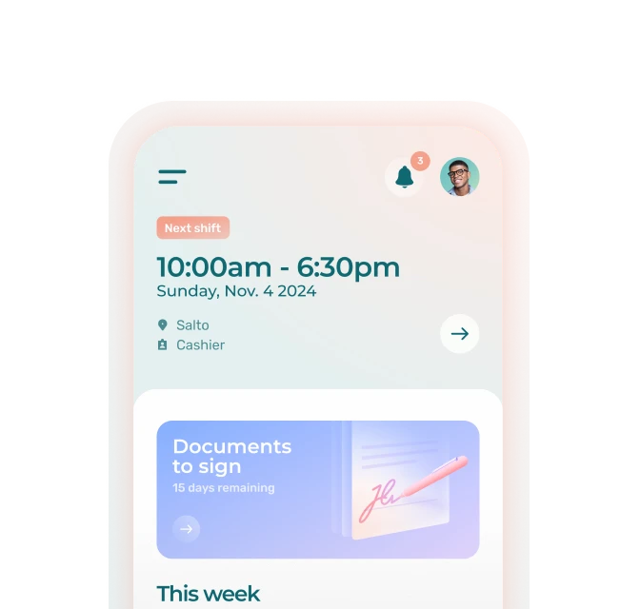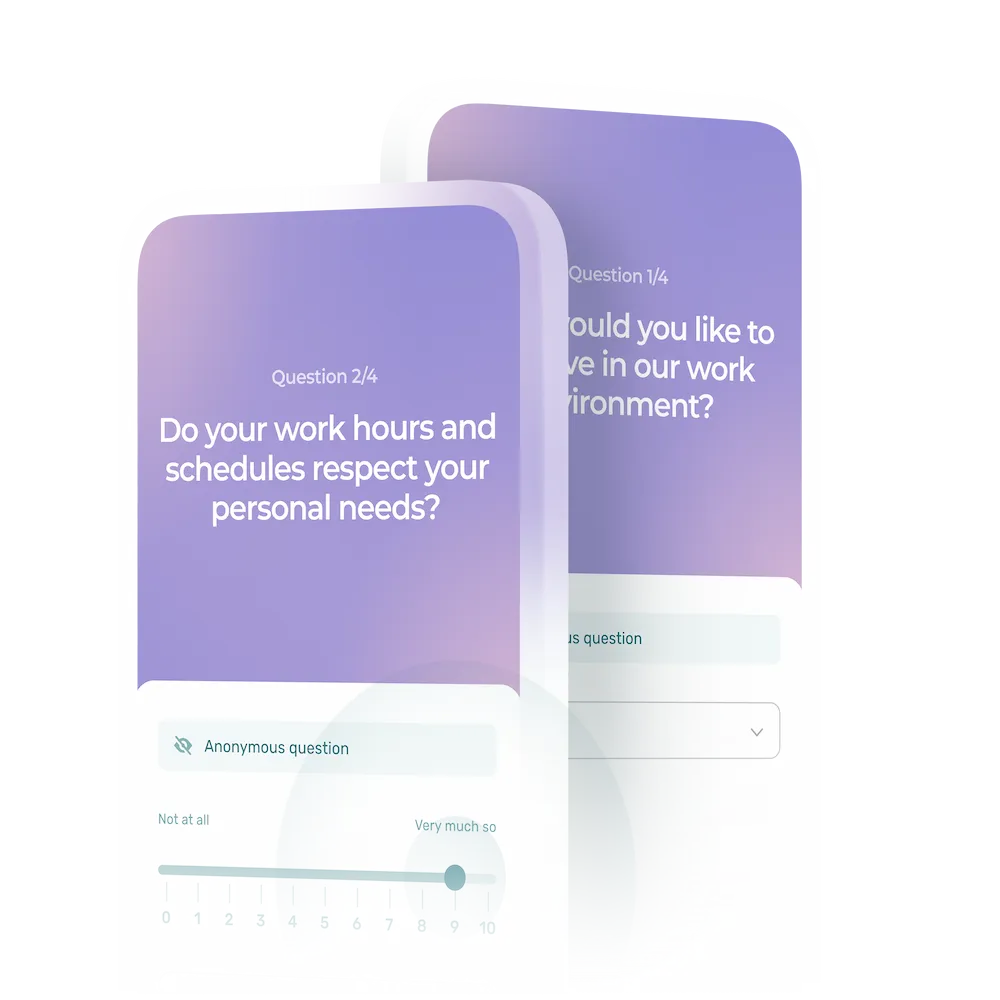Have you ever felt blindsided by an employee’s departure? You’re not alone.This gradual and often subtle process of disengagement can be hard to detect unless you take the time to look for the right indicators.
This is where employee engagement metrics come into play.
According to Workleap, regularly measuring engagement helps managers and HR professionals better understand their teams and pinpoint areas for improvement. In fact, AssessFirst highlights that this approach helps in developing effective strategies to create a work environment conducive to professional growth.
In a world where talent is valuable and turnover comes at a high cost—especially for frontline employees—closely monitoring engagement indicators helps detect warning signs. It’s better to act early than to wait until disengagement turns into a resignation.
Employee Engagement: A Key Factor in Retention
What Does Engagement Mean for Frontline Employees?
Engagement is what motivates an employee to bring their best—even on a rainy Monday. It’s the energy they invest in their work, their sense of belonging, and their desire to be part of something greater. As explained in this article on employee expectations, a workplace built on transparency and mutual respect fosters consistent engagement.
As outlined in our article Special Feature on Employee Engagement (+ 20 Key Drivers):
Employee engagement means that an employee doesn’t just work for a salary or job security. They believe in the company’s mission and want to contribute to its success. Work engagement is a decisive factor in the sustainability of the employer-employee relationship.
Satisfaction vs. Engagement
An employee can be satisfied with their schedule and salary but still not be engaged. Engagement goes beyond that—it influences motivation, loyalty, and even the willingness to recommend the employer to others.
Why Does Engagement Directly Impact Turnover?
An engaged employee feels valued, heard, and included, which makes them far more likely to stay. On the other hand, an employee who quietly disengages often ends up leaving without a word.
The 10 Key Metrics to Assess Employee Engagement
Each of the metrics below provides a clear view of employee engagement within an organization. Additionally, each one can be measured easily and effectively:
- Retention rate: Compare the number of employees still on staff at the end of a given period to the initial number.
- Voluntary turnover rate: Divide the number of voluntary departures by the total number of employees over a specific period.
- eNPS (employee net promoter score): Conduct a survey asking, “Would you recommend our company as a workplace?” on a scale of 0 to 10.
- Absenteeism rate: Track unplanned absences using your scheduling and timesheet management tool.
- Participation in internal surveys: Analyze response rates and the comments provided.
- Quality/Frequency of feedback: Hold weekly or monthly check-ins, through one-on-one meetings or online surveys.
- Participation in team activities: Keep attendance records or observe spontaneous involvement.
- Job satisfaction: Conduct internal surveys on work environment, equipment, and workload.
- Development opportunities: Track completed training sessions, promotions, and active career plans.
- Spontaneous suggestions: Measure the volume and diversity of ideas submitted through formal and informal channels.
1. Retention Rate
How to measure it: Compare the number of employees still on staff at the end of a given period to the initial number.
What it measures: The percentage of employees who remain over a set period.
A low retention rate often signals a deeper issue. Do some new hires leave within just a few weeks? It’s not always about salary or scheduling—sometimes, they simply don’t feel welcomed or supported. Strong retention often starts with a well-structured onboarding process.
🔗 Related: 20 Effective Talent Retention Strategies for SMEs in 2025
2. Voluntary Turnover Rate
How to measure it: Divide the number of voluntary departures by the total number of employees over a given period.
What it measures: The percentage of employees who choose to leave the company.
If your most reliable or experienced team members are the ones leaving, it’s time to ask why. Do they feel valued? Do they still see a future with your company? A high turnover rate isn’t just a number; it’s a subtle alarm signaling that something isn’t right.
3. eNPS (Employee Net Promoter Score)
How to measure it: Ask employees, “Would you recommend our company as a workplace?” and calculate the score on a scale from 0 to 10.
This simple question is surprisingly powerful. A high score indicates a strong workplace culture. A low score, on the other hand, might mean your employees wouldn’t even mention their job at a family dinner…
4. Absenteeism Rate
How to measure it: Track unplanned absences using your scheduling tool.
What it measures: The frequency of unplanned absences, which can indicate disengagement.
A spike in unplanned absences—especially on Fridays and Mondays—can be a red flag for growing disengagement. When motivation fades, employees may find countless excuses to skip work. Over time, what seems like occasional absences might actually signal a deeper need for support or recognition.
5. Participation in Internal Surveys
How to measure it: Analyze survey response rates and the quality of comments provided.
What it measures: Employee willingness to share feedback and their perception of being heard.
Even a skipped survey sends a message. When employees feel heard, they participate. But if they believe that nothing changes or that their responses are just for show, they will disengage. Have you ever asked them directly what they’d like to see measured?
6. Quality and Frequency of Feedback
How to measure it: Assess the frequency of check-ins and the quality of exchanges through one-on-one meetings or HR tools.
What it measures: The level of communication and guidance employees receive.
An employee without feedback is like driving through fog without GPS—you’re moving, but you don’t know if you’re on course. A kind word, a suggestion for improvement, or a quick nod to a job well done—these don’t require a formal meeting to make a difference. Feedback may seem subtle, but it’s a powerful driver of engagement.
7. Team Activity Participation
How to measure it: Track the participation rate in internal events and gather employee feedback.
What it measures: The level of team spirit and employee engagement during group activities.
It’s often said that those who laugh together work better together. If no one shows up to team events, it could be a sign that the team spirit is fading. Sometimes, a simple coffee break with snacks builds more camaraderie than an elaborate outing.
8. Job Satisfaction
How to measure it: Use internal surveys focused on the work environment, available tools, and role perception.
What it measures: Employees’ overall satisfaction with their work setting and resources.
Ask directly: Are you happy here? The answer, even when silent, will tell you everything. The ergonomics of the workspace, the quality of the tools, the clarity of expectations—these details, when combined, can enhance or undermine well-being. And you’ll find that a satisfied employee radiates positivity to others.
9. Development Opportunities
How to measure it: Track completed training, promotions given, and career goal discussions.
What it measures: Opportunities for employees to grow professionally within the organization.
An employee who sees no future will eventually feel stuck. Providing training, greater responsibilities, or even just a conversation about their aspirations can make a world of difference. You might be surprised—many people stay not for the money, but for the chance to grow.
10. Volume of Spontaneous Suggestions
How to measure it: Track the number of ideas or proposals received, whether through an idea box, a survey, or direct conversations.
What it measures: The level of employee engagement and initiative.
When ideas are flowing, it’s often a sign that employees are invested. Radio silence, on the other hand, can speak volume. You can try something simple: ask them, in person or on paper, “What could we improve this week?” The responses might surprise you.
How to Use These Metrics to Prevent Turnover
Engagement and well-being metrics are more than just numbers—they’re powerful tools for preventing turnover. Used wisely, they help spot early warning signs, take action at the right time, and create a healthier, more sustainable work environment.
1. Spot the Warning Signs
Certain behaviors or patterns in your HR data should raise red flags. For example:
- A spike in unplanned absences or repeated lateness may point to mental fatigue or growing disengagement.
- A noticeable drop in participation during meetings or internal communications could signal a lack of interest or increasing isolation.
- Signs of burnout—like irritability, withdrawal, or inconsistent productivity—should never be ignored.
By regularly monitoring these indicators, you can step in before someone even starts thinking about leaving.
2. Take Targeted Action
Once you’ve identified the signs, it’s time to take action. Here are a few ideas:
- Relevant training: Whether it’s stress management or professional development, the right support can rekindle motivation.
- Recognition programs: Celebrating small wins and showing appreciation strengthens team spirit.
- Scheduling adjustments: Offering more flexibility or reworking shifts to fit individual needs can go a long way in improving work-life balance.
The key is to tailor your approach to your team’s reality.
3. Create a Continuous Improvement Loop
Preventing turnover isn’t a one-time fix—it’s an ongoing process. Here’s a simple way to keep improving:
Measure → Discuss → Adjust → Repeat
- Regularly track key indicators like engagement, satisfaction, or absenteeism.
- Start conversations with your team to understand the why behind the data.
- Adjust your tools, processes, or working conditions based on what your team actually needs.
- Repeat—because people’s needs are always evolving.
Case Study: A Senior Residence Improving Retention with Data
Context
A senior residence in a rural area, with a team of about thirty employees, was experiencing significant staff turnover, particularly among beneficiary attendants. The voluntary turnover rate was over 45%, which stressed managers and disrupted the residents’ stability.
Implementing Engagement Metrics
The management decided to take a more proactive approach. Using a tool like Agendrix and quarterly surveys, they began tracking:
- Retention rate
- eNPS
- Absenteeism
- Employee suggestions
- Participation in internal surveys
Initial Results
After a few weeks, several key observations emerged:
- Absenteeism was higher among employees who had not received formal feedback in the past three months.
- eNPS was particularly low during evening shifts, where peer support was less present.
- Few suggestions were submitted, indicating a need to foster a culture where employees feel heard.
Concrete Initiatives Implemented
- Daily recognition: Managers are encouraged to acknowledge at least one positive action each day, even if it’s just a note in the communication log or a quick mention during a break.
- Monthly listening circles: Every month, a small group of employees meets with management to openly discuss their concerns and ideas. These circles create a safe space for open dialogue.
- Peer mentorship: New employees are paired with an experienced colleague to ease their integration and establish a sense of trust from day one.
- Internal development: A highly engaged caregiver is promoted to team leader after completing a short leadership training offered by the residence.
Results After Six to Twelve Months
- The turnover rate decreased from 45% to 28%.
- The eNPS increased from 10 to 30.
- The work atmosphere is warmer, and several employees express pride in working at the residence.
By focusing on simple yet telling data, the residence successfully created a more humane, stable, and engaging environment—benefiting both the residents and the staff.
Act Now to Protect Your Teams
Regularly checking in with employees is more than just a management exercise—it’s a sign of respect. By tracking these metrics and taking action with humanity, you’ll build a workplace culture your team wants to be part of.
You’ll realize that in a labor market facing shortages, engagement is not a luxury, but a crucial investment.
So, what will you focus on tomorrow morning?
How to Effectively Measure Employee Engagement?
Use key indicators such as retention rate, voluntary turnover rate, eNPS, absenteeism rate, and participation in internal surveys to assess employee engagement.
What Is the Difference Between Employee Satisfaction and Engagement?
Satisfaction refers to general well-being at work, while engagement reflects motivation, loyalty, and the desire to actively contribute to the company.
Why Is Employee Engagement Crucial for Reducing Turnover?
An engaged employee feels valued and involved, making them less likely to leave the company, thus reducing staff turnover.
What Is eNPS and How Do You Use It?
eNPS (Employee Net Promoter Score) measures the likelihood of your employees recommending your company as a workplace, providing insight into their engagement.
To make things easier, download our free eNPS Excel calculator.
How to Interpret a High Absenteeism Rate?
A high absenteeism rate may indicate growing disengagement or internal issues that require attention.
What Tools Can Help Track These Metrics?
HR software like Agendrix or survey tools such as Officevibe or TINYpulse can help track and analyze these indicators.
How to Encourage Participation in Internal Surveys?
Ensure that employees understand the importance of their feedback and show that their responses lead to tangible actions.
What Role Does Feedback Play in Employee Engagement?
Regular and constructive feedback helps employees feel recognized and supported, thereby strengthening their engagement with the company.
How to Promote Development Opportunities Within the Company?
Offer training, mentorship opportunities, and regularly discuss career aspirations with your employees to encourage their growth.
Why Is It Important to Collect Spontaneous Suggestions from Employees?
Spontaneous suggestions reflect employees’ investment in improving the company and can provide valuable ideas for organizational development.













